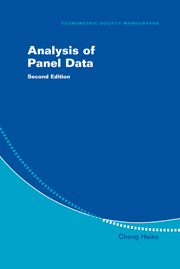Book contents
- Frontmatter
- Contents
- Preface to the Second Edition
- Preface to the First Edition
- Chapter 1 Introduction
- Chapter 2 Analysis of Covariance
- Chapter 3 Simple Regression with Variable Intercepts
- Chapter 4 Dynamic Models with Variable Intercepts
- Chapter 5 Simultaneous-Equations Models
- Chapter 6 Variable-Coefficient Models
- Chapter 7 Discrete Data
- Chapter 8 Truncated and Censored Data
- Chapter 9 Incomplete Panel Data
- Chapter 10 Miscellaneous Topics
- Chapter 11 A Summary View
- Notes
- References
- Author Index
- Subject Index
Chapter 7 - Discrete Data
Published online by Cambridge University Press: 14 May 2010
- Frontmatter
- Contents
- Preface to the Second Edition
- Preface to the First Edition
- Chapter 1 Introduction
- Chapter 2 Analysis of Covariance
- Chapter 3 Simple Regression with Variable Intercepts
- Chapter 4 Dynamic Models with Variable Intercepts
- Chapter 5 Simultaneous-Equations Models
- Chapter 6 Variable-Coefficient Models
- Chapter 7 Discrete Data
- Chapter 8 Truncated and Censored Data
- Chapter 9 Incomplete Panel Data
- Chapter 10 Miscellaneous Topics
- Chapter 11 A Summary View
- Notes
- References
- Author Index
- Subject Index
Summary
INTRODUCTION
In this chapter, we consider situations in which an analyst has at his disposal a random sample of N individuals, having recorded histories indicating the presence or absence of an event in each of T equally spaced discrete time periods. Statistical models in which the endogenous random variables take only discrete values are known as discrete, categorical, qualitative-choice, or quantal-response models. The literature, both applied and theoretical, on this subject is vast. Amemiya (1981), Maddala (1983), and McFadden (1976, 1984) have provided excellent surveys. Thus, the focus of this chapter will be only on controlling for unobserved characteristics of individual units to avoid specification bias. Many important and more advanced topics are omitted, such as continuous-time and duration-dependence models (Chamberlain (1978b); Flinn and Heckman (1982); Heckman and Borjas (1980); Heckman and Singer (1982); Lancaster (1990); Nickell (1979); Singer and Spilerman (1976)).
SOME DISCRETE-RESPONSE MODELS
In this section, we briefly review some widely used discrete-response models. We first consider the case in which the dependent variable y can assume only two values, which for convenience and without any loss of generality will be the value 1 if an event occurs and 0 if it does not. Examples of this include purchases of durables in a given year, participation in the labor force, the decision to enter college, and the decision to marry.
The discrete outcome of y can be viewed as the observed counterpart of a latent continuous random variable crossing a threshold.
Information
- Type
- Chapter
- Information
- Analysis of Panel Data , pp. 188 - 224Publisher: Cambridge University PressPrint publication year: 2003
